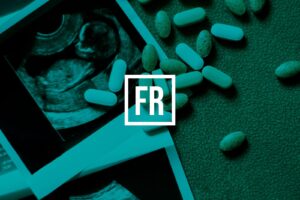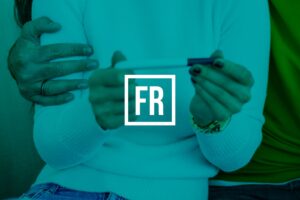The use of donor sperm in conception has been reported anecdotally for hundreds of years. In comparison, double donation, the use of donor eggs and donor sperm, is a relatively new treatment.
What does double donation mean?
Double donation should not be confused with embryo donation when a previously created embryo is donated to a recipient. These embryos are usually donated by patients who have already completed their family and do not wish their surplus embryos to be discarded or donated to research. Whereas with double donation, donor eggs and donor sperm, are chosen by the recipient to create their own unique embryos for use in their treatment.
Since 1991, UK clinics have had a legal obligation to report all treatment cycles undertaken to the Human Fertilisation and Embryology Authority (HFEA). This data has since been published and has shown that during the last 30 years, there has been a 40-fold increase in cycles when both donor eggs and donor sperm are used. During the period 1991-2019, the birth of 3000 children has been recorded.
Why is double donation on the increase?
There are a number of reasons for the increase in the use of double donations. Firstly, couples who have had repeated failed cycles using their own gametes may decide that it will increase their chance of pregnancy. The UK has always struggled to find donated embryos and despite attempts by a number of charities to create a ‘surplus embryo’ register, this has never got off the ground. Patients are generally reluctant to donate their surplus embryos to other couples, perhaps in part due to the perceived complexity of their own children having a full genetic sibling outside the family unit.
Moreover, single women who require donor sperm, tend to start their fertility journey at a later age when the use of an egg donor, instead of their own eggs, provides a significantly higher chance of success. The increasing availability of donor gametes internationally has led to a wider choice and the general increased acceptance of different modes of conception has also opened the door for more individuals embarking on double donation treatment.
How does double donation work?
The pathway to double donation involves a number of steps:
1. Finding your egg donor
Finding an egg donor can be a time-consuming process. The demand in the UK far outstrips the supply, particularly if you require a donor from an ethnic minority group. This often leads to patients accepting a donor from another ethnicity or opting to travel abroad for their egg donation cycles. Cross-border reproductive care is often a successful route but introduces its own challenges and should be carefully researched if this is your pathway of choice.
There are two types of egg donors: fresh and frozen. Historically, fresh donors were used, which involved the synching of the donor and recipient, with a fresh transfer planned for both. However, more recently, the use of frozen donor eggs is more common. This has a number of advantages: it not only gives flexibility for the timing of embryo transfer (ET), but it also ensures that there are fewer cancelled treatments since the availability of embryos is confirmed prior to ET scheduling. The recorded cycle success rates using frozen eggs and fresh eggs is very similar despite fewer frozen eggs being allocated per cycle. It should also be remembered that with frozen eggs, Intracytoplasmic Sperm Injection (ICSI) is always required, to compensate for the impact of the freezing process on the outer shell of the egg.
Due to the challenges of finding an egg donor, recipients may need to be flexible with the treatment venue. There are some egg banks in the UK that are closely affiliated to a particular clinic and therefore patients must register with them prior to selecting an egg donor. International egg donors are available for import in some cases.
2. Selecting your sperm donor
In comparison, the process of sperm donor selection has been established for many years. If a suitable donor is not available locally, it’s fairly easy to import samples from overseas and the costs are comparable. Once a donor has been selected, the sperm quality needs to be considered. Since an egg donor is being used it is not necessary to purchase ‘washed’ samples. The washing process, to remove the cryoprotectant, is a standard part of the thawing and preparation process in your treatment centre. So paying for this step is not required. Also, if you are using frozen donor eggs, a lower-quality sample (count and motility) can be chosen. You will be having ICSI fertilisation, where only one sperm is needed per egg received. Higher-quality samples are needed if you are not intending to have ICSI as part of your treatment.
3. Selecting your egg and sperm donors
Egg and sperm donor selection can be a complex process. Often initial requirements seem very clear but through viewing different donor profiles, recipients’ likes and dislikes may change. Historically, it was common for a racial match to be the first consideration, but now family units are much more ethnically diverse and therefore things are not so ‘black and white’.
Generally, a recipient would first consider which physical characteristics would work for their family unit. When double donation is involved, it is more common for couples to decide that they wish to match themselves. However, with the increasing number of single women choosing double donation, priorities have changed. Although one of the donors may be chosen as a match to themselves or to their wider family group, the second donor may be chosen purely on personality traits, hobbies or academic success. This opens the door for much more diversity in the donor pool, where previously only those donors that were deemed attractive enough were selected.
Historically, matching the donor’s CMV (Cytomegalovirus) status with your own would be a consideration. CMV if contracted during pregnancy, can have a detrimental impact on your foetus’s development. However, it is now standard practice to screen all donors (egg and sperm) to ensure the active virus is not present.
Blood group matching was also once considered a crucial part of donor selection. This was not always for medical reasons. Some families wanted to ensure that if they chose to keep their use of donation a secret, it would not be accidentally discovered in a medical emergency, by having a child whose blood group was not a match for a parent.
Removing both of these exclusion criteria has greatly increased patient choice and should be discussed with your treating clinician if you are concerned.
4. Donor half-siblings
In the UK, any donor can legally contribute to the creation of 10 family groups. This does not mean 10 children, but 10 families who may decide to have more than one child. Therefore, with double donation, if both donors reach their maximum family quota, there is a chance that your resulting child may be linked to up to 20 different families with multiple offspring. However, although it is usual for a sperm donor to contribute to his full family quota, the nature of the egg donation process is self-limiting with most egg donors contributing to less than 5 families. If you decide to opt for a donor who is not recruited in the UK, you may wish to consider the number of half-sibling families you would feel comfortable with.
Although imported donors do have to meet the 10 UK family limit, they may have been used internationally where the family limits are higher or not so closely regulated.
5. The treatment
Once your donors have been chosen and if frozen, are safely stored at your chosen clinic, it is time to start considering when you wish to have treatment. If you are using fresh donor eggs, this may depend on the donor’s availability. If using a donor as part of an egg-sharing arrangement, the timing will be when your donor intends to have her own treatment. As mentioned previously, a fresh embryo transfer (ET) can only be accomplished if you are able to synchronise your cycle with the egg collection date. For many, this proves tricky and the decision to freeze any resulting embryos is the better option with a frozen embryo transfer (FET) planned for a later date.
In comparison, when using frozen eggs and frozen sperm, treatment can be planned to either match your normal menstrual cycle (a natural FET) or programmed in a medicated cycle. Either way, the creation of the embryos can be organised to aim for a blastocyst ET on Day 5 post egg and sperm thaw, which is known to give you the best chance of pregnancy. Again, the created embryos can be frozen and used in a FET if preferred.
6. The outcome
With all treatment cycles, the outcome is dependent on many factors. However, when using donor eggs and donor sperm, negative contributing factors are greatly reduced. All donors go through an exhaustive number of tests and assessments and approximately 95% are rejected from the donation program for reasons ranging from medical history to motivation to donate.
The best example of the success of this strict recruitment is the removal of the impact of age on egg quality. As we all know, egg quality declines with age. All egg donors, recruited in the UK must be below the age of 36. This is clearly demonstrated by the published HFEA data for birth rate per cycle in double donation, for female patients between the age of 45-50 years (1991 – 2019) which is listed as 32% (fresh ET). In comparison the same age group, using partner sperm and patient eggs is documented as 2% birth rate/cycle (fresh ET).
If you’re considering Double Donation, useful sources of information can be found at: The Donor Conception Network (DCN) and the Human Fertilisation and Embryology Authority (HFEA).






